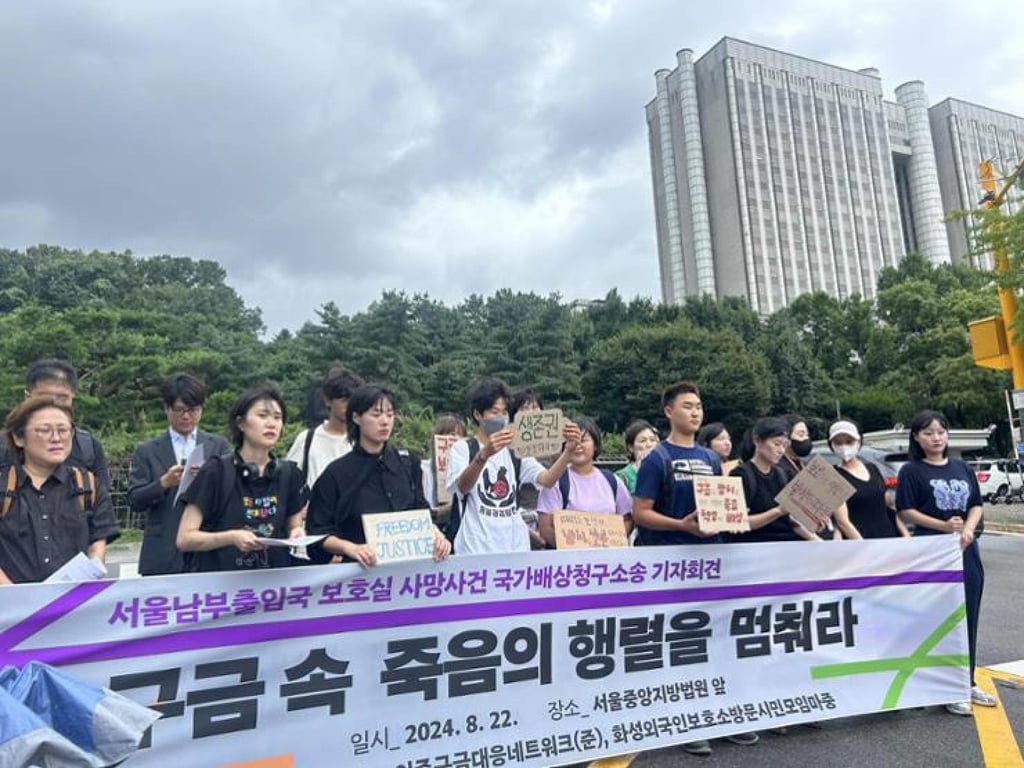The family of a Chinese man who died earlier this year at an immigration facility in Seoul filed a lawsuit against the government on Thursday alleging that his death was a result of negligence and a lack of proper medical attention.
Migrant rights activists say that the death highlights widespread human rights violations in South Korea’s immigration detention facilities, where detainees often endure inhumane treatment and are deprived of basic needs.
Duroo, an association for public interest law representing the bereaved family of the deceased, held a press conference in front of the Seoul Central District Court, where the family filed a lawsuit against the government seeking 56 million won (US$42,000) in compensation.
According to the lawyers, the Chinese national died on the evening of January 1 at the Seoul Southern Immigration Office in Gangseo district, two weeks after being detained when officials discovered his visa had expired. The autopsy revealed that he died from peritonitis caused by a ruptured liver abscess, exacerbated by his severe diabetic condition.
The detainee, who suffered from chronic illnesses including diabetes and high blood pressure, requested medical attention multiple times, but officials ignored the requests, the lawyers said.
“I visited my husband several times while he was detained, and it was clear that his health was deteriorating,” his wife said during the press conference. “On the morning of the day he died, he called a friend to say he was so sick he felt he was going to die. Yet the officials still ignored him.”
She, also a Chinese national, wished to remain anonymous due to concerns about potential visa-related repercussions.
“I and my young son lost the breadwinner of our family in a sudden death that could have been prevented if he had been allowed to go to the hospital just once.”
She also mentioned that a police investigation into the incident concluded without holding any immigration officials accountable, attributing the cause of death to chronic health conditions.
“Do I have to endure this unfair situation just because I’m a foreign woman with poor Korean skills and can’t afford a lawyer? Where is the justice?” she added.

The facility where the Chinese man was held operates as a temporary holding centre, detaining foreign nationals accused of visa violations until their cases are processed. Detainees typically stay there for days or even weeks while awaiting deportation or the completion of administrative procedures.
Lawyer Lee Han-jae of Duroo alleged that the immigration office violated relevant laws, which state that upon admission to a detention facility, a foreign national must undergo a physical examination.
“The rule also stipulates that if a foreign national is ill, they must receive medical care from a doctor. If there isn’t a doctor available at the facility, the officials must call in a doctor or the patient must be transferred to an outside medical institution for treatment,” Lee explained.
“The essence of this case is that the minimum necessary actions required for detaining a person were not taken at all.”
Sim Ah-jung, a migrant rights activist, emphasised that this incident is one of the many preventable deaths occurring in immigration detention facilities, citing a similar incident at the Busan Immigration Centre on August 16, 2022.
“In the name of ‘protection,’ non-Korean nationals are being detained in immigration facilities across the country, suffering from mental and physical harm. These facilities are intended as temporary holding centres for administrative processes, not places to hold people indefinitely,” she said.
The Korea Times reached out to the Ministry of Justice for comment, but they did not respond at the time of writing.
This story was first published by The Korea Times


